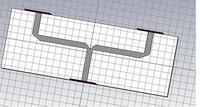vioamethyst
Member level 3

i currently in progress of designing lossless power divider, T-junction
i use equal power divider (with input feed 50ohm), connected to QWT*, and to the output feed which will later combine to antenna.
the feed is connected to QWT and directly attach to 50 output feed iwhich is bent (+ mitter bent)
when simulating my results, i obtain S11 which is well below -10dB, but unfortunately for my S22=S33= -8dB which is bad, if im nt mistaken, this happen due to significant loss.
what can i adjust to my design, so that i can obtain better value of s-parameter?
(without changing to other types of power divider eg wilkinson power divider, my power divider suppose to works on 3.5GHz)
*QWT= quarter wave transformer
here i attach along , some related files for your reference, thx in advance
i use equal power divider (with input feed 50ohm), connected to QWT*, and to the output feed which will later combine to antenna.
the feed is connected to QWT and directly attach to 50 output feed iwhich is bent (+ mitter bent)
when simulating my results, i obtain S11 which is well below -10dB, but unfortunately for my S22=S33= -8dB which is bad, if im nt mistaken, this happen due to significant loss.
what can i adjust to my design, so that i can obtain better value of s-parameter?
(without changing to other types of power divider eg wilkinson power divider, my power divider suppose to works on 3.5GHz)
*QWT= quarter wave transformer
here i attach along , some related files for your reference, thx in advance



